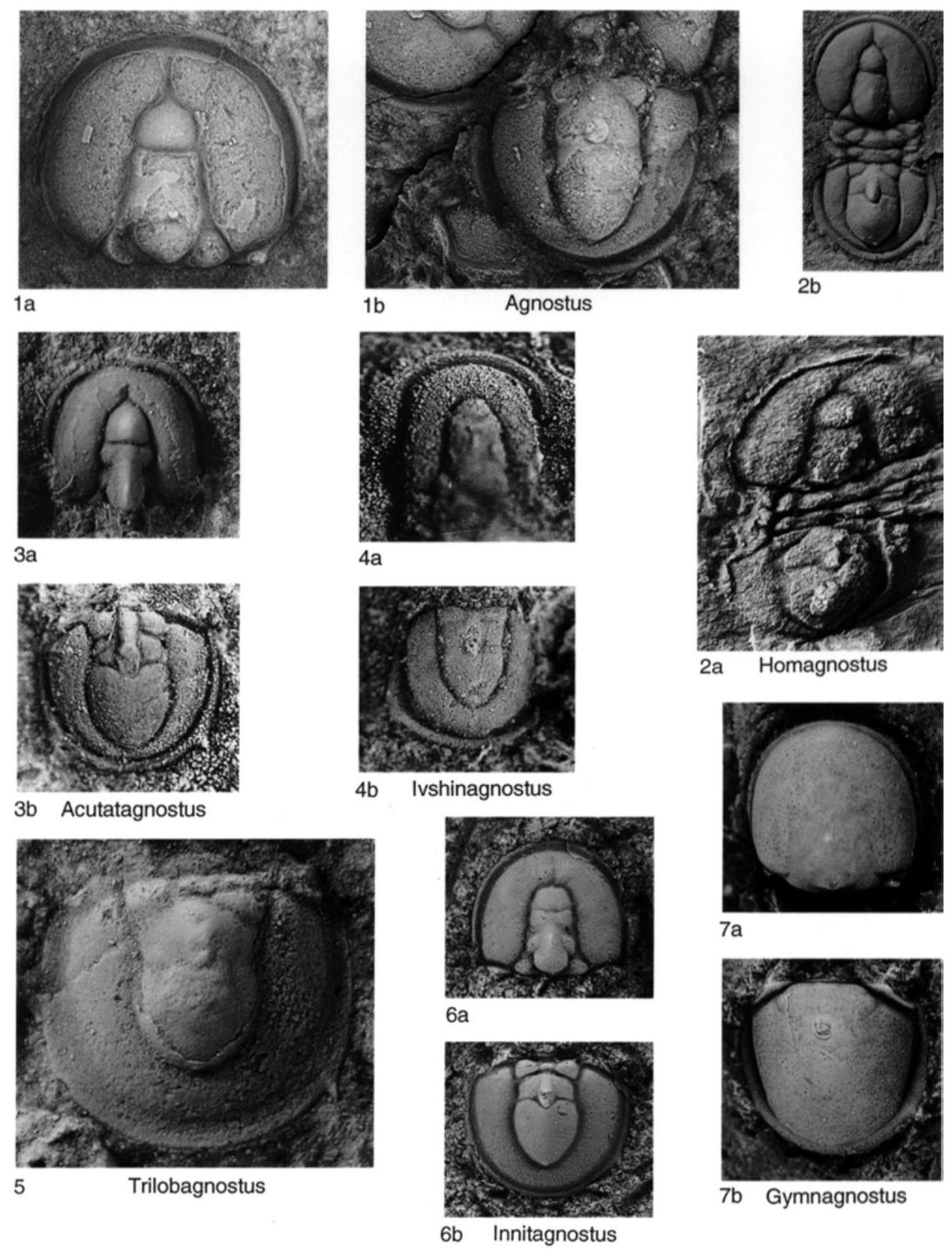Welcome to the Treatise on Invertebrate Paleontology!
Please enter a genera name to retrieve more information.

Innitagnostus
Classification
Phylum:
Arthropoda
Class:
Trilobita
Order:
Agnostida
Superfamily:
Agnostoidea
Family:
Agnostidae
Formal Genus Name and Reference:
Innitagnostus ÖRІК, 1967a, p. 98
Type Species:
* I. innitens, OD, holotype (ÖРІК, 1967, pl. 58, fig. 2), СРС 5853, AGSO, Canberra
Images
(Click to enlarge in a new window)
Fig. 217,6a,b. *I. innitens, Upper Cambrian (Mindyallan, G. stolidotus Zone), western Queensland (Boulia district); a, holotype, cephalon, CPC 5853, × 8; b, topotype, pygidium, CPC 5854, ×8 (new).
Synonyms
Geographic Distribution
China (Guizhou, Hunan); Australia (Queensland), MindyallanIdamean (E. eretes to S. diloma Zones); Russia (Siberia), Kazakhstan, G. stolidotus to P. curtare Zones; Canada (Northwest Territories, British Columbia, Newfoundland), Glyptagnostus reticulatus to Olenaspella regularis Zones; USA (Alabama, Nevada, Texas), Aphelaspis Zone.
Age Range
Beginning Stage in Treatise Usage:
Upper Cambrian
Beginning International Stage:
Guzhangian
Fraction Up In Beginning Stage:
50
Beginning Date:
498.75
Ending Stage in Treatise Usage:
Upper Cambrian
Ending International Stage:
Cambrian Stage 10
Fraction Up In Ending Stage:
100
Ending Date:
486.85
Description
Median preglabellar furrow variably developed, Glabella with broad, trapeziform anterior lobe, F3 well impressed, nearly straight, Posterior lobe with well-developed F1 and F2, Lateral portions of M2 commonly separated from midmost glabella by weak longitudinal (exsag.) furrows, Glabellar node located from midway between F1 and F2 to level with F2, Basal lobes of moderate size, trapezoidal, Pygidial axis of moderate length, constricted across M2, M1 trilobate, F1 well impressed, bent forward, F2 straight laterally, bent rearward by strong axial node, Posterior lobe ogival to semiovate, usually narrowly rounded posteriorly, not reaching border furrow, Median postaxial furrow absent
References
Museum or Author Information
Classification
Phylum:
Arthropoda
Class:
Trilobita
Order:
Agnostida
Superfamily:
Agnostoidea
Family:
Agnostidae
Formal Genus Name and Reference:
Innitagnostus ÖRІК, 1967a, p. 98
Type Species:
* I. innitens, OD, holotype (ÖРІК, 1967, pl. 58, fig. 2), СРС 5853, AGSO, Canberra
Images
(Click to enlarge in a new window)
Fig. 217,6a,b. *I. innitens, Upper Cambrian (Mindyallan, G. stolidotus Zone), western Queensland (Boulia district); a, holotype, cephalon, CPC 5853, × 8; b, topotype, pygidium, CPC 5854, ×8 (new).
Synonyms
Geographic Distribution
China (Guizhou, Hunan); Australia (Queensland), MindyallanIdamean (E. eretes to S. diloma Zones); Russia (Siberia), Kazakhstan, G. stolidotus to P. curtare Zones; Canada (Northwest Territories, British Columbia, Newfoundland), Glyptagnostus reticulatus to Olenaspella regularis Zones; USA (Alabama, Nevada, Texas), Aphelaspis Zone.
Age Range
Beginning Stage in Treatise Usage:
Upper Cambrian
Beginning International Stage:
Guzhangian
Fraction Up In Beginning Stage:
50
Beginning Date:
498.75
Ending Stage in Treatise Usage:
Upper Cambrian
Ending International Stage:
Cambrian Stage 10
Fraction Up In Ending Stage:
100
Ending Date:
486.85
Description
Median preglabellar furrow variably developed, Glabella with broad, trapeziform anterior lobe, F3 well impressed, nearly straight, Posterior lobe with well-developed F1 and F2, Lateral portions of M2 commonly separated from midmost glabella by weak longitudinal (exsag.) furrows, Glabellar node located from midway between F1 and F2 to level with F2, Basal lobes of moderate size, trapezoidal, Pygidial axis of moderate length, constricted across M2, M1 trilobate, F1 well impressed, bent forward, F2 straight laterally, bent rearward by strong axial node, Posterior lobe ogival to semiovate, usually narrowly rounded posteriorly, not reaching border furrow, Median postaxial furrow absent
